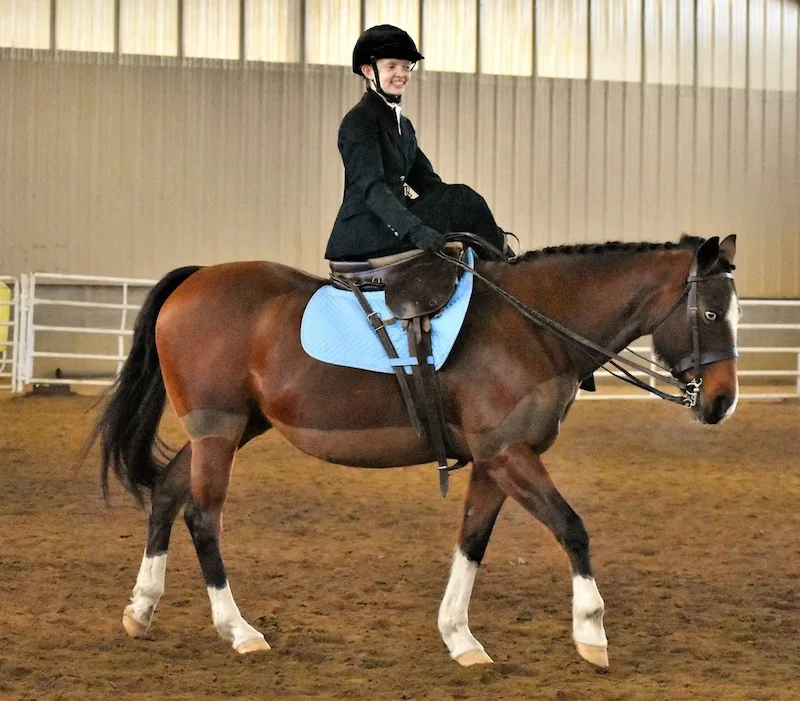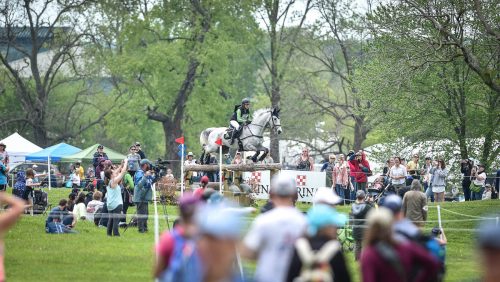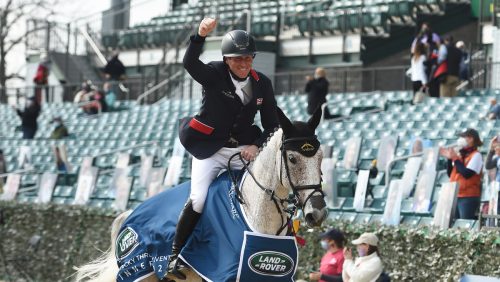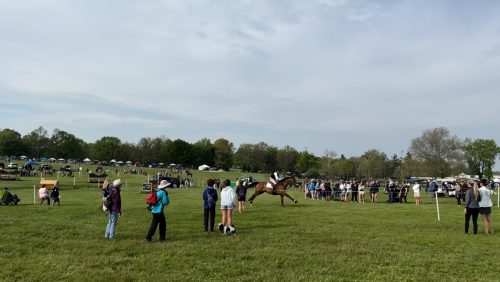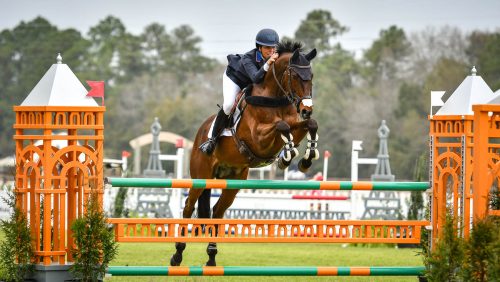When Samantha Peterson, 31, rides by her competitors in the warm-up area at events, she gets a lot of second looks.
“They do a double take. They ask: ‘How in the hell are you staying up there?’ ‘Is that legal?’ and, ‘Oh my gosh, I haven’t seen that in years,’ ” she said with a laugh. “Overall, the reception is pretty positive.”
Peterson, of Lexington, Kentucky, events her 16-year-old Quarter Horse Pixie in a side-saddle. The pair has been competing at the beginner novice level in unsanctioned events on their central Kentucky circuit, but this spring they plan to step it up by entering the May-Daze at the Park Horse Trials at the Kentucky Horse Park. They will move back to starter level for what Peterson anticipates will be a more challenging event.
One of the most common questions she gets from fellow riders after the initial shock wears off is: “Is that saddle legal?”
“We do our research ahead of time and make sure we know what rulebook we’re under,” she said. “If it’s not expressly forbidden, most shows are happy to have people competing.”
ADVERTISEMENT
Peterson had a long-held fascination with a scene in the movie “The Princess Bride” where Robin Wright, playing the heroine Buttercup, is shown wearing a billowing red dress while sitting side-saddle atop a horse in medieval garb. Peterson was thinking back to that scene while working late one night and did some Googling. She had been a pleasure rider for several years by that point and was delighted to find a side-saddle rider near Cincinnati who could show her the ropes. After just one lesson, Peterson rode aside in the Kentucky Derby Pegasus Parade in Louisville.
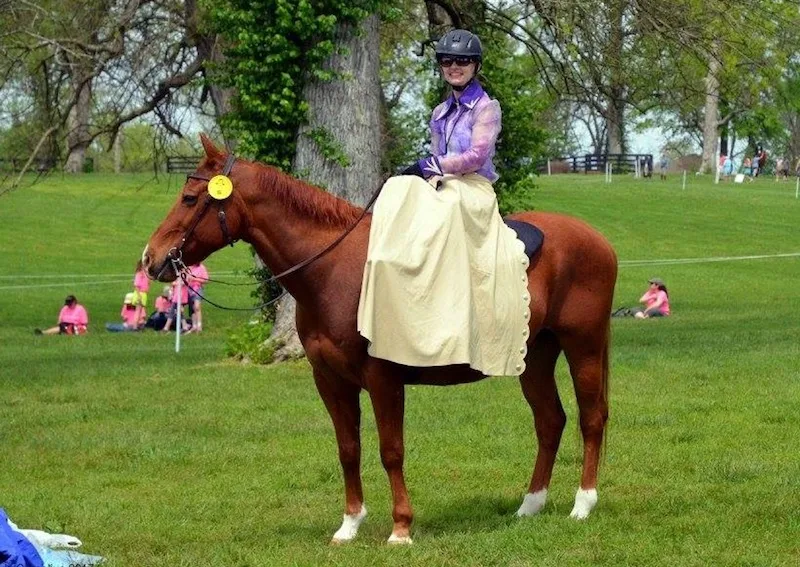
Samantha Peterson riding Oakley during the 2017 Rolex Kentucky Three-Day Event. “That apron is all leather and heavier than heck,” Peterson said. Photo by Kimberly Cornelius.
Peterson said Pixie (like most horses) acclimated to the side-saddle in about five minutes. Riders take a bit longer. Side-saddle riders carry a cane that can be used to simulate the right leg, and horses seem to have no difficulty converting cues from leg to cane.
“My cane is very technical: It’s a half-inch dowel rod from Wal-Mart,” Peterson joked. “I have a fancy one for showing, but for everyday riding, it’s the dowel rod. You can touch them at the girth or behind the girth.”
Contrary to how it may look, the side-saddle rider is sitting with her seat and shoulders square to the horse, the same way an astride rider does. This allows a side-saddle user to control and direct the horse with their seat, which becomes more important in the absence of a right leg. For most English riders, the most challenging part of the transition is jumping: Side-saddle riders sit with their center of gravity farther back, behind the bascule of the jump, so it’s not necessary for them to adopt a traditional two-point. Peterson said a modest lean will do to follow the horse’s effort.
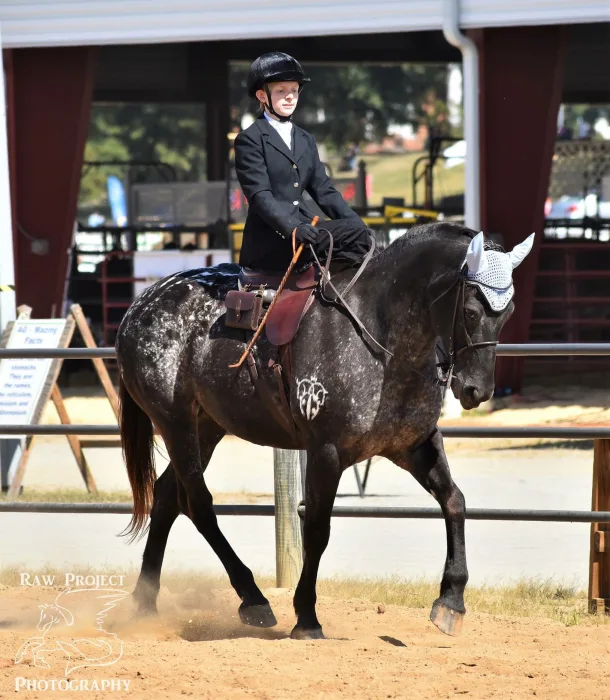
Samantha Peterson and HexenHammer, an American Sugarbush Harlequin Draft mare, owned by Trinity Appaloosa Farm. Photo by Raw Project Photography.
Peterson said she feels more secure riding in a side-saddle than conventional saddles, although she will occasionally ride astride if she’s in a hurry, as the tacking-up process is quicker.
ADVERTISEMENT
“It is secure to the point that we say you cannot ride a rearing horse in one because if the horse is rearing, you can’t bail,” she said. “My mentor Maggie [Herlensky] had a horse she was breaking out. She’d ride in a western saddle, and this horse could get her off every time. She tried it in her side-saddle, and so long as she could get her legs around the horn, the horse couldn’t buck her off and gave up pretty soon after.”
Side-saddle riding has enjoyed a renaissance in recent years. Peterson guesses there are about 30 members in the Kentucky Sidesaddle organization and several hundred nationwide who participate in the American Sidesaddle Association. The television show “Downton Abbey,” which features foxhunters and steeplechase riders in side-saddles, has helped inspire more equestrians to try it. Peterson thinks there are other factors, too.
“We’re also getting younger people into side-saddle riding, and they’re better marketers,” said Peterson. “We’ve had more presence on social media and getting photos out to other riders. There have always been a few side-saddle riders in every generation, but I think now we have more visibility.”
Competing at May-Daze has been a goal of Peterson’s for a long time. She’s a relative newcomer to eventing—she made the transition after years of pleasure riding while she boarded at an eventing barn. The other riders made it look like so much fun, she had to give it a try. The sport is also new to Pixie, whom Peterson and her wife have brought along from green-broke to polished event horse.
Another part of Peterson and Pixie’s transition was saddle fit, which can be a challenge for side-saddle riders. Peterson said there are relatively few modern side-saddles out there, and many need to be modified to fit an individual horse or rider appropriately. Peterson’s is a 30-year-old copy of an antique English side-saddle. Peterson also has a western side-saddle, which is more curvy than the English version and has a deeper seat.
“Occasionally you’ll find a side-saddle that’s 24 inches long, which is the equivalent of an 18- or 19-inch seat,” she said. “Most of them, you take those apart, and there’s a gentleman’s name on the tree. They were usually made for veterans who came home from the various wars missing limbs. They still had to get places and do their jobs. There’s so much history to side-saddle riding.”


